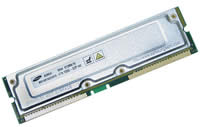Difference between RDRAM and SDRAM
Key Difference: SDRAM is a type of dynamic random-access memory that is synchronized with the system bus. RDRAM is a type of memory that can provide a fast current memory with a maximum speed of 100 MHz and transfers data up to 800 MHz.
Various different forms of RAM (Random-Access Memory) were introduced following the popularity of the computer. In order to make the computers faster, simpler and more technologically advanced, new types of RAM and other components were produced. RDRAM and SDRAM are two types of RAM that are available in the market.
Random-Access Memory (RAM) is a volatile memory used for data storage on a computer. The name states the memory can be accessed in a random order, without having to alter or read other data. This stores data that is used by programs, however once the computer is shut down, the data is wiped out. RAM comes in the form of microchips of different sizes such as 256MB, 512MB, 1GB, 2GB etc. The higher the data capacity, the more programs RAM can support. Computers are designed, so that RAM can be increased up to a certain capacity. RAM has two types: Static RAM (SRAM) or Dynamic RAM (DRAM). In SRAM, data is held in a flip-flop form, where each flip-flop holds a bit of memory. This data does not need constant refreshing is fairly faster than DRAM, however it is expensive and is only used as a cache in a PC. DRAM has memory cells paired with a transistor and capacitor requiring constant refreshing.
 Synchronous dynamic random access memory (SDRAM) is a type of dynamic random-access memory that is synchronized with the system bus. It runs at a higher clock speeds than conventional memory, running at 133 MHz. It is also the predecessor to the DDR SDRAM modules that we use in our computers today. SDRAM has a synchronous interface, which means that it must wait for a clock signal before responding to controls inputs. The clock controls the different types of commands that the SDRAM performs and also pipelines the commands. Pipelining a command allows the chip to start on another command, without having to finish the first command and working on them simultaneously. The data storage area is divided into different sections allowing the chip to access several data at the same time.
Synchronous dynamic random access memory (SDRAM) is a type of dynamic random-access memory that is synchronized with the system bus. It runs at a higher clock speeds than conventional memory, running at 133 MHz. It is also the predecessor to the DDR SDRAM modules that we use in our computers today. SDRAM has a synchronous interface, which means that it must wait for a clock signal before responding to controls inputs. The clock controls the different types of commands that the SDRAM performs and also pipelines the commands. Pipelining a command allows the chip to start on another command, without having to finish the first command and working on them simultaneously. The data storage area is divided into different sections allowing the chip to access several data at the same time.
The concept of synchronous DRAM has been around since the 1970s, while the SDRAM was introduced in the 1993 by Samsung. The SDRAM became instantly popular and by 2000 it had replaced all other types of DRAM in modern computers. However, SDRAM comes with a few limitations such as read cycle time, with the lowest time being 5 nanoseconds for DDR-400, the time remains till date. Another limitation includes the CAS latency, or the time between supplying a column address and receiving the corresponding data. Even with the limitations, it remains popular due to its low cost and other features.

The Rambus dynamic random access memory (RDRAM) was developed by the Rambus Inc. in the mid-1990s as a replacement for then DIMM SDRAM memory architecture. It was quickly licensed by Intel in 1997 for its future motherboards. RDRAM is a type of memory that can provide a fast current memory with a maximum speed of 100 MHz and transfers data up to 800 MHz. RDRAM was expected to become a standard for VRAM, however it ended up in a standards war with DDR SDRAM and lost to it in price, and performance. RDRAM is being used in some graphics accelerator boards in place of VRAM and is also being employed in Intel’s Pentium III Xeon processors and Pentium 4 processors. RDRAM did not become popular due to high licensing fees, high cost, being a proprietary standard, and low performance advantages for the increased cost.
DRAM controllers required that memory modules be installed in sets of two, while any remaining opening slots should be filled with continuity RIMMs (CRIMMs). Though, CRIMMs did not provide any extra memory, they were used to transmit signal to termination resistors on the motherboard. CRIMMs resemble RIMMs in appearance, but do not have internal circuits. RDRAM’s limitations included increase in latency, heat output, manufacturing complexity, and cost. Because of the design, the RDRAM’s die size was also bigger than SDRAM chips. RDRAM is still used in video gaming consoles such as Nintendo 64, PlayStation 2 and PlayStation 3. It is also used actively in video cards.
Image Courtesy: en.wikipedia.org, maximumpc.com









Add new comment